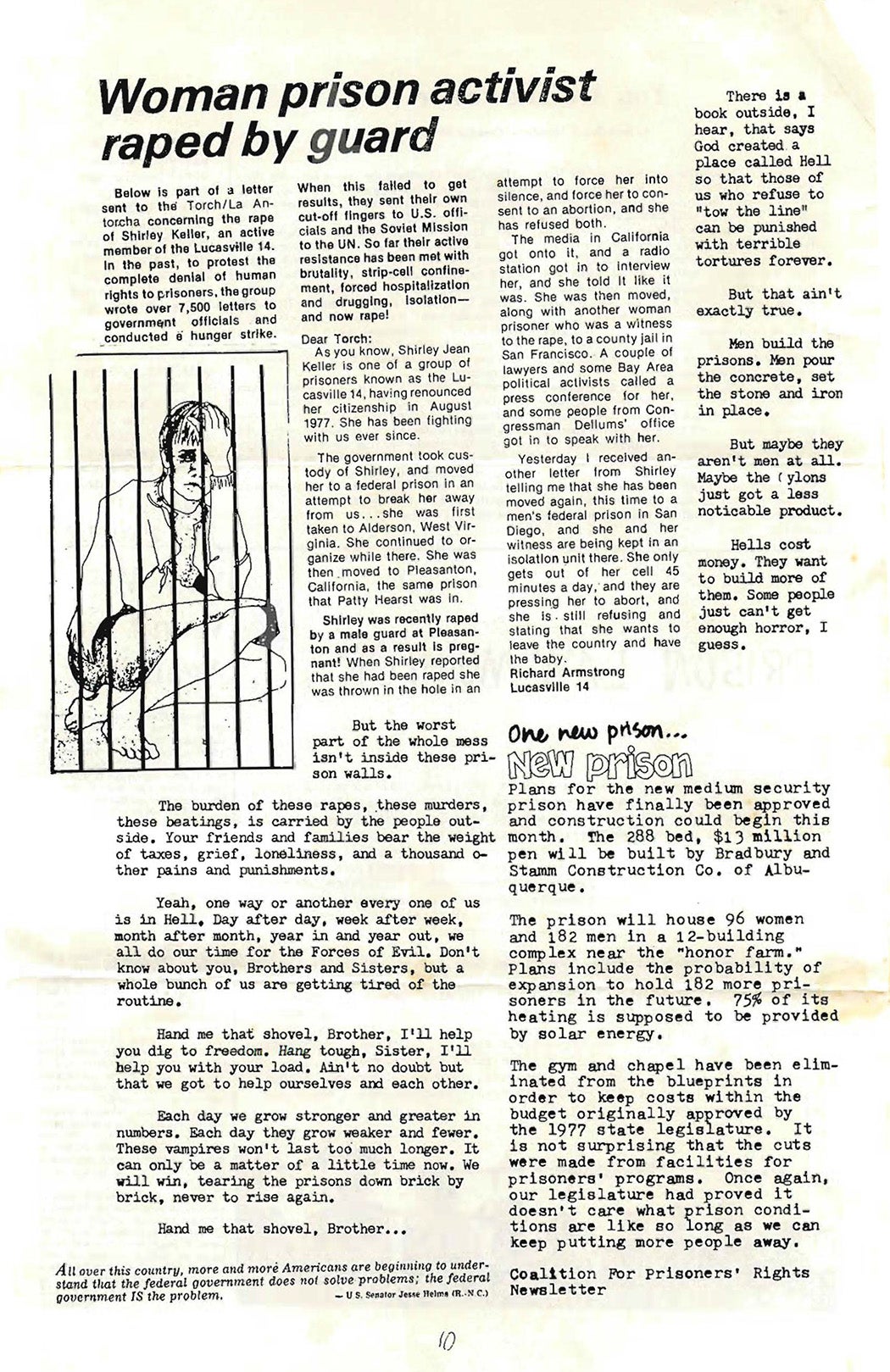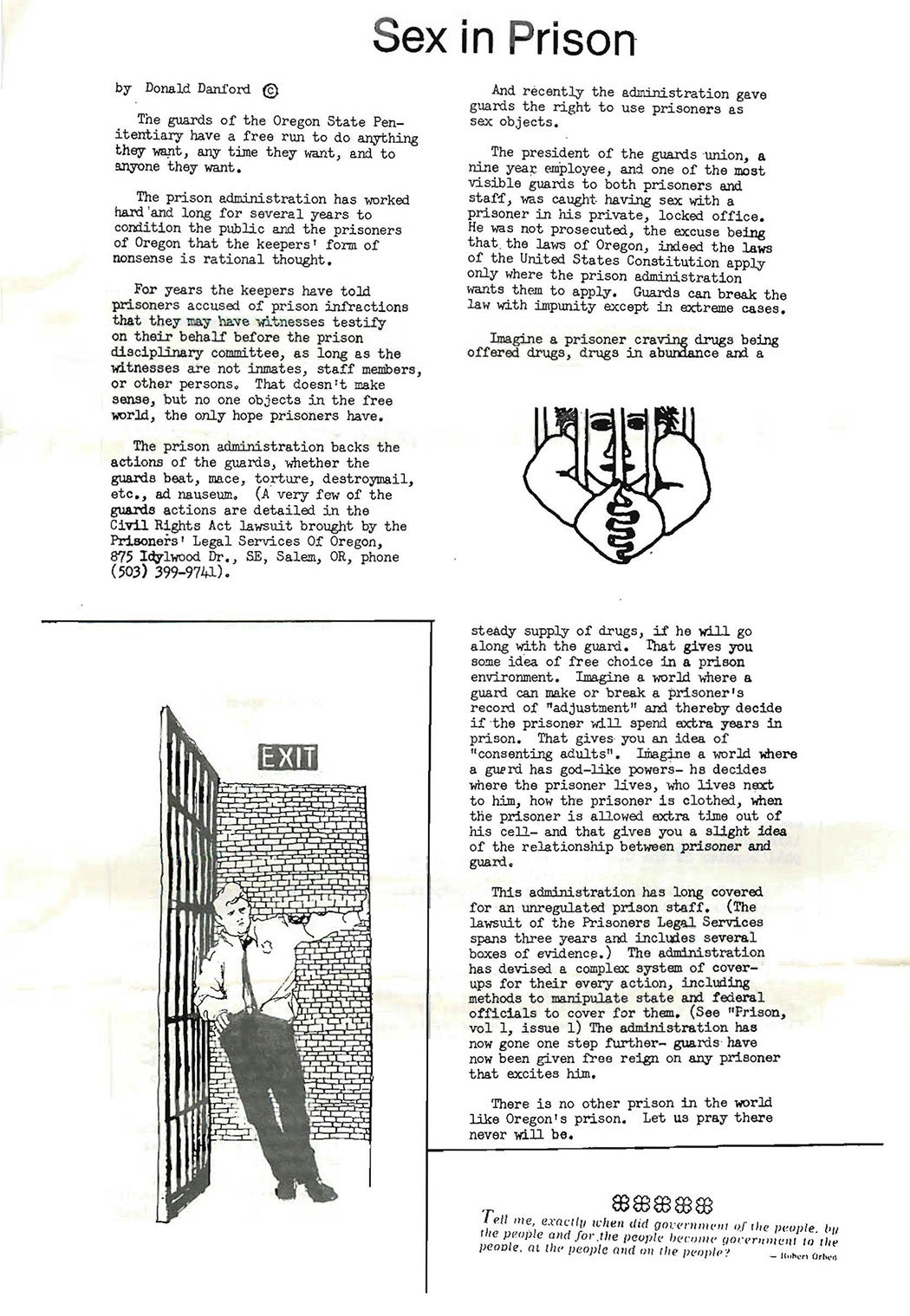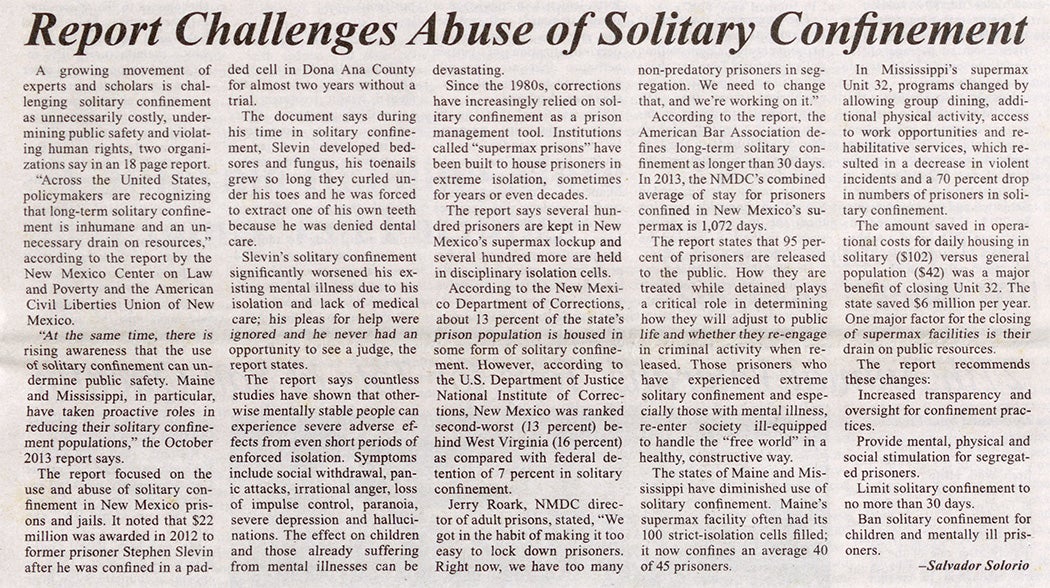Research shows that the criminal justice system leaves an imprint not just on the body, but on the psyche. The effects linger long beyond release for the incarcerated person or the end of a shift for those working in prisons. One of those effects that’s well-documented is learned helplessness.
Martin Seligman first observed learned helplessness when he was doing experiments on dogs. When dogs had been conditioned through exposure to believe that electric shocks were preventing their escape, they no longer even attempted it, instead remaining confined. They had learned they were helpless and acted as if they were, even when they were no longer. This 50-year-old theory has been used to explain a wide swath of human behaviors that seem counterintuitive, often resulting from either confinement or trauma.
Weekly Newsletter
It was this theory that loomed heaviest in my mind the day a federal judge sentenced me to 52 months in federal prison. Already a practicing therapist, I was in the first year of my doctoral education in psychology the day I was sentenced. I feared becoming the dogs, conditioned to accept shocks, abuses, and injustices without attempting to escape. I feared losing my mind—not in a bout of madness, but rather losing the ability to use my mind to freely exert choices over my behaviors and circumstances.

* * *
In addition to learned helplessness, the infamous Stanford Prison Experiment research also helps explain the lasting psychological effects of incarceration not only for prisoners but for guards as well. Conceived to study prison life, the Stanford Prison Experiment began with an average group of healthy, intelligent, middle-class college men. The researchers assigned one half of the men to be prisoners and the other half to be guards based on a coin flip. Their social contexts and backgrounds were similar.
This similarity reflects the reality inside prisons. While people that are incarcerated are often depicted as fundamentally different than the correctional officers tasked with overseeing them, they have more similar backgrounds than many realize. Being a correctional officer is a low-prestige job, with pay that varies between low and median depending on the jurisdiction. Moreover, thirty-eight percent of Federal Bureau of Prisons staff are BIPOC and 42% of the people incarcerated within their prisons are, as well.
There was even less difference in the real-life socioeconomic and cultural backgrounds among the participants of the Stanford Prison Experiment. And yet, the participants’ outcomes in the study varied wildly and were heavily dependent on which role they were assigned to play: prisoner or guard. One of the key takeaways of the short-lived experiment was just how readily people conform to social roles they are expected to play, especially when said roles are as heavily stereotyped as those of prison guards. The Stanford Prison Experiment has been heavily criticized in recent years, but it is one piece of research in a large body that shows how group dynamics and internalizing roles, even when simply to obediently comply with authority, can lead people that are kind as individuals to perpetuate harms within a group.
I saw correctional officers—and other prisoners—behave in ways that can only be understood through these theories. The roles had been defined for us, with decades of pop culture references and deeply engrained stereotypes reinforcing each other. As if we had been randomly selected by the flip of a coin instead of a judge’s gavel, the people assigned to the role of correctional officer seemed to internalize it. They were told, through external cues, that they had power over other human beings. For those of us in prison khakis, others had power over us. Situation after situation confirmed that we were helpless to effectuate change in our lives, and needed to fully subjugate ourselves to those who held the power.

In prolonged confinement, much like the dogs who were conditioned to accept the shocks in Seligman’s study, people instinctively internalize a learned sense of inferiority, helplessness, and weakened ego strength. Meanwhile, correctional officers internalize having power over human beings, however artificial. Philip Zimbardo, the researcher behind the Stanford Prison Experiment, even predicted this outcome. He said that circumstance motivates people to act in the way that they do more so than their baseline personality.
I witnessed this “power over” dynamic daily while incarcerated. I used to walk around the track during my free time, which was one of the few recreational activities available to me. This was an attempt daily to mindfully keep my ego strength in order—I was referred to as “inmate Lipton” and had to remind myself that was only a construct, not a reality.
One of the most salient experiences of my incarceration occurred on that track. A group of “inmate workers” had unfortunately crossed paths with a correctional officer not known for his compassion, Mr. West. He had seized one of the women’s MP3 players—that belonged to her and was bought off commissary—under a false pretense of her not being allowed to have it during work hours. He told her she could get it back on one condition. “Lay on the ground and put your legs in the air like a cockroach,” he demanded, without a trace of irony. Without the psychological framework of his “power over” us having permeated his mind and actions, I’m unsure there’s an explanation for exposing another human being to such humiliation.
The pervasive culture of the prison and its environment promotes correctional officers to adopt the prison identity. Once that identity has been adopted, so has the violent culture that can accompany it. Yet our minds cannot cleanly be divided in two distinct halves, the “work half” and the “life half.” Internalizations about power and authority over others bleeds through a correctional officer’s whole life, even as they cycle “inside” and “outside” of prison as their shifts come and go.

* * *
Research into domestic violence offers some insight into the behaviors of correctional officers. They have disproportionately high rates of intimate partner violence, suicide, substance use issues, and alcohol use disorder. Research suggests that it this is more likely a result of the psychological impact of their chosen career than a result of the personalities of those who go into the profession.
Studies into the psychology and circumstances of domestic violence provide surprising insights into this behavior. Evan Stark, author of the book Coercive Control: How Men Entrap Women in Personal Life provides an analysis of domestic violence far more nuanced—and according to Cheryl Hanna who reviewed it for the journal Signs, “arguably more accurate,”—than is common in society. While intimate partner violence is often attributed to men who have poor impulse control (i.e., they are a bad character/person) and strike their partners because they can, Stark argues that the abuser’s behavior is better understood as preventing the other from attaining freedom and autonomy (i.e, in relation to others).
Hanna’s summation of Stark’s theory proves informative in analyses of correctional officers’ behavior. “Stark advocates redefining abuse from specific acts to ‘an ongoing and gender-specific pattern of coercive and controlling behaviors that cause a range of harms in addition to injury’ (99–100).” The physical violence is but the most visible system of an interlocking web of harmful behaviors, all designed to subjugate. How does it affect your psyche when the primary function of your job duty is to subjugate others?

A core duty of any corrections employee is to impose coercive systems of control on the people confined to their institution. And yet it is that very concept that may form the basis for later incidents of domestic violence in their homes. As their workplace role of dominator or controller of people gets internalized more and more deeply, it seeps into the other aspects of their personal life.

* * *
Humans are born with nearly 100 billion neurons. Synapses are brain structures that allow neurons to transmit an electrical or chemical signal to other neurons. Through synaptic pruning that occurs in childhood and early adolescence, the brain destroys extra synapses. People lose up to 50% of their synaptic connections during adolescence. The main change is that unused connections in the thinking and processing part of children’s brain (called the grey matter) are ‘pruned’ away. At the same time, other connections are strengthened. This is the brain’s way of becoming more efficient, based on the ‘use it or lose it’ principle. This process occurs throughout our life and explains some of the brain changes that occur during long-term incarceration.
The process of neural plasticity (changes in the neural nets), designed to optimize our brain structure to suit the needs of our circumstance, will therefore optimize to embrace the circumstance of either being the “incarcerated person” or the “correctional officer.” Unlike leaving prison—which is an utter binary, in/out—neural plasticity (the brain being shaped by our experiences) occurs gradually and over time. This plasticity reinforces the power differentials projected upon us.
During my time in prison, despite concerted efforts at resisting it, I internalized my subjugation. I became conditioned to eat exactly what was given to me, without question or complaint. Upon release, I found myself at restaurants and adopting the implicit pattern of accepting what I was given. Despite the fact I was a paying customer, I couldn’t bear to complain when my meal showed up and was not what I ordered. I simply ate it, even when it was a food that disgusted me; I didn’t even perceive an alternative. My neural net changed, my powerlessness internalized, I had become the helpless prisoner they told me that I was.
Problems arise when there is a mismatch between the synaptic structure and the situation in which someone currently find themselves. Whether an officer has left work after their shift or a person has been released after serving their sentence, their mind does not suddenly revert to the pre-prison state. Their neural network continues to be primed for the role imposed upon them. Whether they have been conditioned to exert dominance, or conditioned to expect subjugation, both states manifest in behaviors that follow the person far beyond the gates of prison.
Mismatches also occur between how we present to the world and how we feel inside. Correctional officers often feel the need to present as “tough,” encapsulated within a 2015 Guardian article titled, “‘Prison guards can never be weak’: the hidden PTSD crisis in America’s jails.” If inside they feel afraid, or plagued by insecurities, the mismatch alone can cause psychological discord.
The rate of PTSD in correctional officers is double that of military veterans. Their suicide rate is double the national average. Incidents of domestic violence are grossly elevated. And yet, receiving psychological treatment is heavily stigmatized within law enforcement communities. And they must keep returning to work, no matter what has occurred the shift before. Correctional officers at the infamously violent jail Rikers Island were recently embroiled in a scandal for abusing sick leave and general absenteeism. The jail is also infamous for suicides of currently and formerly incarcerated people, typified by the suicide of Kalief Browder.

Research shows that re-entering society after incarceration is challenging and rife with barriers. People coming out of incarceration usually lack housing, employment, money, and health insurance. Depending on how long they were incarcerated, they could have severely hampered technological skills in what is increasingly a tech-dependent society. The learned helplessness they were forced to acquire throughout their incarceration is exactly the opposite of what is needed to surmount barriers. (PTSD, it should be noted, is dramatically over-represented in the incarcerated population, too, many of whom are exposed to violence and have disproportional rates of sexual trauma. It also contributes to diminished functioning, making people more susceptible to succumb to hurdles.)

The extreme power differential perpetuated by US prison systems could be one reason the recidivism rate is so high. It could also explain why correctional officers experience so many negative health outcomes. Humans cannot rapidly toggle modes in their mind to align their psyche with their circumstance.

Dr. Kaia Stern is the co-founder of the Prison Studies Project who stumbled almost accidentally onto the connection between poor outcomes for people sent to prison and poor outcomes for those who work in prisons. In her piece, “The Keeper and the Kept,” she quotes a “self-described U.S. Marine and Black man” who worked as correctional line officer for 11 years:
I’m slowly being poisoned over a 35-year period and no one tells me. You think it is you when it manifests in your life: obesity domestic violence, suicide, alcoholism… we don’t have a name for trauma because there’s no training, so people associate [their own trauma] with deviant behavior. And then the [state] agency tells you that the injury you suffer can’t be solely identified to work… If the public really knew the kind of disconnect for humanity.
Unlike military veterans exposed to trauma who can then later be compensated by the VA, correctional officers and incarcerated people are less likely to even be diagnosed and treated, with compensation exceedingly rare.
These negative psychological effects of incarceration are not inevitable. Norway’s Halden prison offers a model for prisons where power differentials are lessened, the emphasis is on education and rehabilitation, and all people no matter their crimes are treated with basic levels of human dignity, in compliance with the United Nations Standard Minimum Rules for the Treatment of Prisoners. As the punitiveness of their prison environment decreased, so did their recidivism. As less recidivism means less crime and less need for further incarceration, states from North Dakota to Oregon have sent delegations to Norway to learn their model of corrections and attempt to implement it back home.
As the Norway model sets the precedent for treatment of people in prison, they greatly improve the mental health of the staff, too. In the officers’ training school, the governor (warden) of Halden prison Are Høidal explains, guards are taught that treating inmates humanely is something they should do not for the prisons but for themselves. The theory is that if officers are taught to be harsh, domineering, and suspicious, it will ripple outward in their lives, affecting their self-image, their families, and even Norway as a whole. Høidal stated a line that is usually attributed to Dostoyevsky: “The degree of civilization in a society can be judged by entering its prisons.







